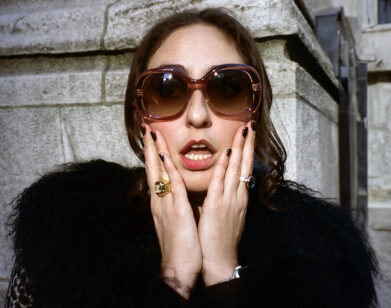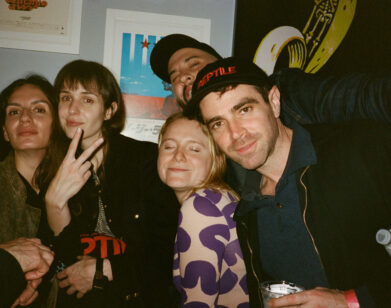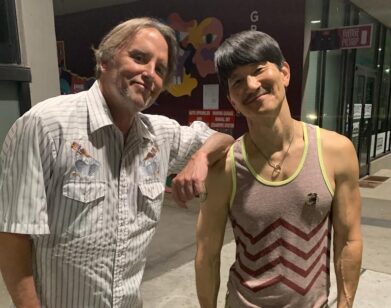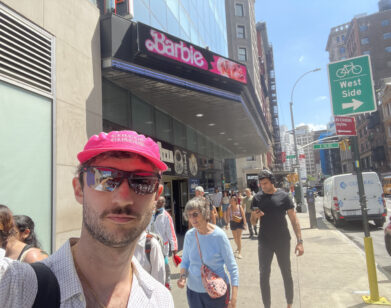let's talk about clothes, baby
Emily Spivack on Turning Her Bestselling Book Worn Stories Into a New Docuseries
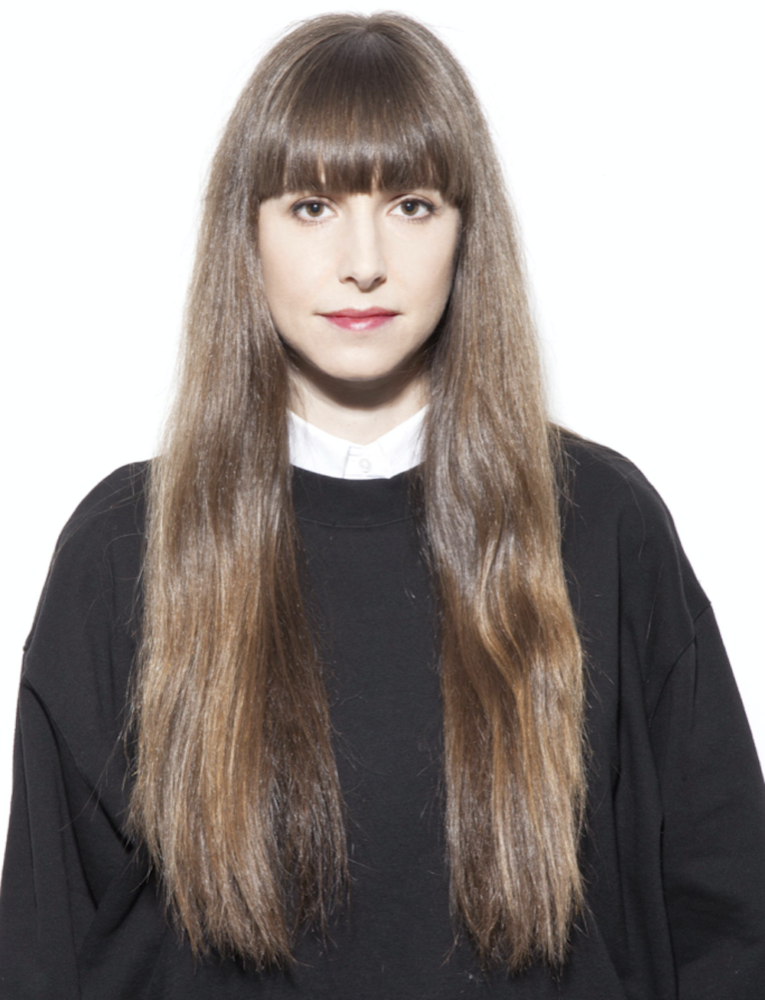
Let’s talk about clothes, baby. When you first begin the new Netflix docuseries Worn Stories, you’re met by a community of nudists located in Kissimmee, Florida who have a rather free relationship with their clothing and personal expression. What follows is both a moving and tender look at how different people and subcultures define themselves by what they wear. From the mind of writer Emily Spivack, Worn Stories began as a book published in 2014 that featured contributors such as Greta Gerwig, Heidi Julavits, Maira Kalman, Sasha Frere-Jones, and Simon Doonan that detailed the roles that different garments played in their lives. The follow-up, Worn in New York, was published in 2017. Now, the eight-part documentary series, which airs today, allows for interviewees, both featured in the books and beyond, to tell their unique and quirky stories. In honor of the premier, Spivack sat down with Interview to discuss the distinction between clothes and fashion, the process of turning her bestselling books into a series, and what we can all learn from good style.
———
JULIANA UKIOMOGBE: Where did your fascination with clothing begin?
EMILY SPIVACK: I think that I’ve always been interested in clothing as a means to express myself creatively, not necessarily high fashion but the sort of one-off, off-the-beaten-path, vintage thrift store kinds of clothes ever since I was in junior high school. I was always dipping my toe into the fashion world, but never finding the right spots for myself, so I wound up creating my own niche.
UKIOMOGBE: You published Worn Stories in 2014. Did you always have plans for it to have a visual component, or did that come a little later?
SPIVACK: So, the book Worn Stories came out in 2014. Worn in New York came out in 2017. I loved, and it was a very deliberate choice, that when you read the books, and you saw the image of the clothing. You filled in the gaps imagining who the person was, what they might look like, what they might sound like, everything like that. But there was a sense that there were some stories where I really felt like, “Ah, I wish there was a visual component. I wish you could see the person. I wish we could actually create fantastical recreations of what they’re telling me.” So, I started thinking about that once the second book came out. I was like, “Yeah, there’s more here.”
UKIOMOGBE: Was it all filmed pre-COVID?
SPIVACK: No. Part of it was filmed pre-COVID. I was able to sit down and talk to a lot of people pre-COVID. But then, COVID struck, and we still had a bunch of shooting to do. I would say a third of it was shot during COVID and then edited and whatnot during COVID as well.
UKIOMOGBE: How do you see people’s relationship to their clothes changing throughout the pandemic? People are purging their closets and also refocusing on what it means to style themselves.
SPIVACK: It’s such an interesting question. I think we’re holding on to things that are meaningful to us. My hope is that where we’ll end up from this pandemic is that when we reach into our closet to put something on, and we will be driven to put it on, we will be motivated to put it on, because of the story connected to it. As opposed to perhaps the designer or which season it came out or in style, but that we’ll be drawn to the meaning behind the clothing a little bit more than perhaps we were before the pandemic. That being said, I also think once this is behind us, we’re going to want to get dressed and have fun and put on some of the clothes that we haven’t been able to wear for a long time and go out and enjoy ourselves. I do think that it’s prompted people to be a little bit more thoughtful about their purchases and what they’re holding on to and why.
UKIOMOGBE: Going back to what you were just saying, what I loved about the show is that it’s not so much a focus on fashion and brands, but more so on people’s personal relationship to their clothes. Do you see a distinction between the word fashion with a capital F and just clothing in general?
SPIVACK: Absolutely. I think what I wanted to do with Worn Stories is say, “Hey, it’s your wedding dress, or it’s a piece of a designer fashion with a capital F, or a pair of ripped jeans, and put them on the same plane and look at clothing as this equalizer.” There’s this commonality. We all wear clothing and there are things that happen to us while we’re wearing our clothes, and those experiences get mapped onto the clothes. So thinking about the universal nature of clothing, thinking about the equalizing nature of clothing, that it’s something that we all are putting on every day. My interest as an artist is taking something that’s commonplace like clothing or objects, and just looking at it through a slightly different lens and saying, “Well, what does this tell us about who we are?”
UKIOMOGBE: How did you find all your interview subjects? Were they all from the books, or did you broaden your horizons beyond the books?
SPIVACK: I would say about half of them are from those books. I’ve been collecting these stories since 2010, so I’ve talked to so many people. I’ve accumulated a lot of stories. I just knew that there were more out there. And so, the show is organized thematically. It would be like, “Okay, we have a person who’s representing this niche or this part of culture. Let’s go and reach out to someone else and just accumulate stories.”
UKIOMOGBE: Do you have a favorite episode in the series or a favorite segment?
SPIVACK: Well, it’s so hard to pick one favorite. I think that all of these stories are doing different things. But I would say that one that really represents the series for me is Simon’s story with the biker shorts. It feels like, through this one mundane pair of biker shorts, we’re able to see a cultural history of Los Angeles in the ’80s. Through these biker shorts, we’re able to get a sense of what was happening with the AIDS epidemic told through the absurdity of the aerobics that he was doing while wearing these biker shorts. I feel like it’s a cultural history of a moment in time. That feels to me like something that’s really representative of the ethos of the show.
UKIOMOGBE: Were there any stories that shocked or surprised you? I’m thinking of the nudist episode.
SPIVACK: What I think I continue to be surprised by is how much people will open up to me based on telling their story through a piece of clothing. When I started the project back in 2010, people were sharing things with me that I just had never heard them tell me before and I was blown away. What I continue to be surprised by is people who say, “Oh my god, I’ve never told this story before. I’ve never shared this with anyone.” That is always so satisfying, and it feels just like such an intimate experience to have with the person that I’m interviewing. I continue to just feel like I’ve been given access in this amazing way to the subjects who I’m speaking to. It’s also just been fun to get to know people who may have sat down with me for an interview for my book. We’ve gotten to know each other over the years, and then I call them back and say, “Hey, do you want to be on the show?” and get to sit back down with them. Simon is another example where I hadn’t seen him in years, and then we got to sit down again.
UKIOMOGBE: Is there a common through-line that you found with interviewing all of these people that connects them?
SPIVACK: It really varied for me. I’m not sure. It’s a hard question to answer. Because I think what I have found to be interesting is there are some garments that we get that we either purchase or are given to us for a special occasion like a wedding, for example, and then there are the clothes that are just our everyday things and something crazy or momentous or spectacular happens while we’re wearing those clothes. It’s just fascinating to me, especially for those clothes where there wasn’t an intention when it was purchased, and then this incredible thing happens. I’m thinking about the difference between, say, Timmy Cappello, who says Tina Turner gave him the codpiece and he can’t go on stage without it and it’s very intentional, but then there’s Mrs. Park, who is in the Korean dance troupe. She’s given a yellow sweater by a Buddhist monk, and it gives her comfort and gives her confidence to perform with her dance troupe. Those could not be more different people, and yet there’s a common thread in terms of the confidence that it gives them. So, I liked finding those kinds of things. That’s what I really want people to come away with and be able to put that together. But I do think that these stories, I hope, show our collective human experience as told through clothing.

